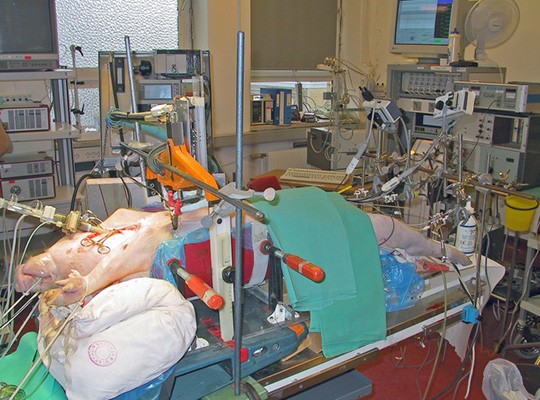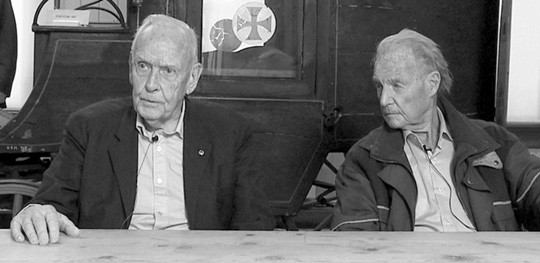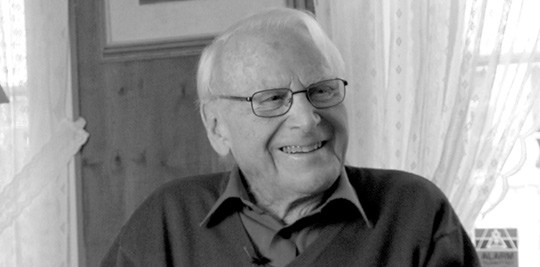
Pig on the operating table at the Institute for Experimentel Medical Research at Ullevål hospital in about year 2000. This is the same operating theatre that we used 30 years earlier. Photo: Roy Trondsen
Nine renal transplants were performed on humans at Harvard and Peter Bent Brigham hospitals between 1951 and 1953, three using living and six using cadaver donors. Four of these kidneys secreted urine 37 to 180 days before they were rejected. All the patients died. In their report David Hume (1917 – 73) and co-workers concluded that «renal homotransplantation has no place in the therapy of human patients at this time» (1).
In 1954 Joseph Murray (1919 – 2012) transplanted a kidney between two identical twins at Peter Bent Brigham Hospital, Boston, USA (2). The recipient lived for 8 years postoperatively and this is accepted as being the first successful organ transplant in the world. It was the first that had a positive influence on the life of the patient. Joseph Murray received the Nobel prize in medicine in 1990, among other things for this achievement.
Erik Thorsby (born 1938) mentions in his article «50 years of organ transplantation in Norway» that Leif Efskind (1904 – 1987) performed the first renal transplantation in Norway and Scandinavia as early as 1956 and that the patient lived for 30 days postoperatively with a kidney from an unrelated donor (3).
In 1963 the first successful renal transplantation in Norway was performed at Ward 3, Ullevål hospital. Under the leadership of Carl Semb (1895 – 1971), Richard Wilson from Peter Bent Brigham hospital transplanted a kidney taken from the patient’s mother. This patient lived for 22 years with the functioning transplanted kidney (3).
In 1967 Thomas Starzl (born 1926) performed the first successful liver transplantation on an eighteen-month-old old girl in Denver, Colorado, the same year that Christan Bernhard (1922 – 2001) in South Africa performed the first heart transplantation. Barnard’s patient died after 18 days, while Starzl’s patient lived for more than 13 months (4,5). Christian Barnard expressed astonishment at all the attention he received, including an audience with the Pope and with President Carter. In 1968 in Cambridge, England, Roy Yorke Calne of Cambridge University (born 1930) performed the first liver transplantation in Europe. Neither Starzl nor Calne received much attention at the time, but they have since been lauded as the «fathers» of liver transplantation.
Liver transplantation experiments on animals
In 1968 Snorre Aune (born 1925) and Gunnar Schistad (1926 – 2014) were both senior registrars at Ward 2, Ullevål hospital, and Andreas Skulberg (born 1924) was a consultant anaesthesiologist. Together they decided to develop a surgical technique for liver transplantation. They started experimental transplantations on animals in collaboration with a team at Rikshospitalet led by Audun Flatmark (1926 – 2004). The latter had worked with Thomas Starzl in Denver and was inspired by him. They also worked closely with Stig Bengmark (born 1929) in Gothenburg, who also worked on developing a technique for liver transplantation in animals. Morten Ræder (1939 – 2012) and I were at that time junior registrars in Ward 2, Ullevål hospital. We were at the beginning of our surgical training and were junior partners in the experimental and clinical work with liver transplantations from the very outset.
We started early in 1968, performing transplants one day a week. We worked alternate weeks at Rikshospitalet, at the Institute for Surgical Research, where the team from Ullevål removed the liver from a donor dog, and the team from Rikshospitalet inserted it, and at the Institute for Experimental Medical Research at Ullevål, where the team from Rikshospitalet removed the liver from a donor pig and we inserted it. Audun Flatmark used a heterotopic technique, inserting the liver ectopically without removing the recipient’s liver. Snorre Aune used an orthotopic technique, removing the recipient’s liver and replacing the transplant anatomically (5). The day before transplantation Morten Ræder and I collected two pigs from the slaughterhouse at Slemmestad in a small van owned by the Institute for Experimental Medical Research. They spent the night in the institute’s animal quarters and were anaesthetised the next morning by the animal caretaker Ove Moen (born 1942) and Andreas Skulberg. We also collected blood at the slaughterhouse. Snorre Aune performed the insertion of the liver assisted by Gunnar Schistad, Morten Ræder and myself, while Andreas Skulberg took care of the anaesthetisation. All the pigs died, both donors and recipients. Morten Ræder and I butchered the dead pigs in the animal quarters, skinned and cut them up in the evening, and divided the meat between members of our team and others at the institute who were interested. The animals were young and tasty and the meat very popular.

Andreas Skulberg (left) and Gunnar Schistad. Screenshot from video interview, reproduced with permission (17). Photo: Kåre Eide
The dogs at Rikshospitalet also all died. Snorre Aune and Gunnar Schistad were highly skilled general surgeons and it is evident that this was, at that time, technically very challenging surgery. The main problems were to minimise the ischaemic time for the liver, and to tackle the venous congestion when the portal vein and vena cava were clamped during the removal of the recipient’s liver. This made the orthotopic technique more challenging than the heterotopic. The anastomoses and the problems with bleeding were other significant challenges.
We had a number of meetings with Stig Bengmark and his team in Gothenburg who also used the orthotopic technique. Their pigs also died. The only surgeon we knew of in Europe whose transplanted pigs survived was Roy Calne in Cambridge.
Pig liver perfusion
In autumn 1968 a girl in her early twenties was admitted to Rikshospitalet with anaemia, oedema and ascites, in addition to oral and perianal ulcerations. Since early adolescence she had been treated for diarrhoea and rectal bleeding, and had never menstruated. Two days after admission she suffered profuse rectal bleeding and went into shock. It transpired that she had ulcerative colitis with an enlarged, cirrhotic liver and a significantly enlarged spleen. She underwent a colectomy and was relatively stable for 24 hours before she had haematemesis from oesophageal varices. The bleeding was stopped with the aid of a Sengstaken-Blakemore tube but the following day she went into liver coma.
We had at that time failed to get any of our transplanted pigs or dogs to survive, so no one thought of performing a liver transplantation on this patient. However, we had considerable experience of removing and preserving a pig liver. There were reports from both the USA and the UK of successful treatment of acute liver coma with extracorporeal, heterologous liver perfusion (7). Although these reports were from experimental cases, Audun Flatmark and his team, together with Aune, Schistad and Skulberg, decided to make an attempt in this patient. Morten Ræder and I collected a pig from Slemmestad; the liver was removed at Rikshospitalet and placed in a sterile plastic bag in a 38-degree water bath. After three minutes of ischaemic time, the liver was perfused for 14 minutes with 2500 ml of saline until the draining fluid was clear and without signs of blood. The liver was then perfused with arterial blood from canulation of both the patient’s femoral arteries to the hepatic artery and the portal vein. The venous blood was returned to the patent’s great saphenous vein using a pulsatile pump. The liver perfusion lasted four hours. Bile production started after 45 minutes, and during the following 3.5 hours the total production was 90 ml. Ammonium in the patient’s arterial blood fell from 160 micrograms per litre to 59, and bilirubin from 10.8 to 6 mg per 100 ml. The next morning the patient responded when spoken to but was not completely awake. Later that day she became progressively comatose. The same evening a new pig liver perfusion was carried out but was unsuccessful. The liver swelled, was much less biochemically active and the patient’s blood pressure fluctuated, indicating that she was bleeding. The bleeding became out of control and she died the next day.
The report of this case history published in the Journal of the Norwegian Medical Association concluded: «We plan to continue to offer this treatment for selected cases, acute hepatitis and toxic liver damage, and will offer this treatment programme to other hospitals which may have such patients admitted.» The treatment was, as far as I know, never repeated in Norway and is thus the only time heterologous pig liver perfusion has been attempted in this country (8).
Visit by Roy Calne
We continued relentlessly to transplant. The pigs at Ullevål and the dogs at Rikshospitalet all died. Nor did Stig Bengmark in Gothenburg have any success. Early in 1969 we contacted Roy Calne in Cambridge and he came to Ullevål. He was a pleasant, quiet man, later knighted for his achievements in the field of organ transplantation. He stood for a whole day in theatre at the Research Institute and watched us transplant a liver into a pig, which died shortly after the surgery. He then said: «You are doing everything right. Just continue and you will see that one day suddenly the pig survives without you knowing what you have done differently. Later on all your pigs will survive. I have experienced this myself». Then he came home with Morten and me and had dinner with us before we drove him to the airport where he took the plane home to Cambridge. I do not know, but I would not be surprised if he paid the tourist class fare himself. What he said was correct. After a short while the recipient pig suddenly survived, and after that every pig we transplanted. The pigs lived and thrived with their transplanted livers until they had to be killed due to lack of space. We had done it. We experienced, as others had reported earlier, that rejection of the pig liver is mild compared to the rejection found in dogs (9).
Liver transplantation in humans.
The first liver transplantation on a human in Norway was performed in summer 1969 at Ward 2, Ullevål hospital. The patient was a man in his forties with liver cirrhosis, oesophageal varices and profuse gastrointestinal bleeding. He had been operated on with gastric transection and a Sangstaken-Blakemore tube was placed in the oesophagus. He was in liver coma when a man with severe head injury was admitted to Ward 3, Ullevål hospital who was regarded as being beyond curative treatment. It was decided to switch off the ventilator. He was accepted as a donor by both Snorre Aune and the head of Ward 3, Frank Bergan (1909 – 1985). The operation lasted for 545 minutes and was technically difficult with significant bleeding problems. The recipient died at 07:00 the next morning.

Snorre Aune. Screenshot of video interview, reproduced with permission (17). Photo: Kåre Eide
The next patient was a woman in her forties who underwent a liver transplant in winter 1970. She had carcinoma of the colon with liver metastases and requested a transplantation. Her primary tumour had been excised radically and there were no other metastases, so that a successful liver transplantation could theoretically be curative. The first operation lasted 570 minutes. She was then re-operated twice within a short period, with cholocysto-jejunostomy (210 minutes) and splenectomy (320 minutes). Altogether the patient was operated on for 1100 minutes, or nearly 21 hours. I remember that we worked continuously for 35 hours with short periods when the patient was off the table. There were considerable problems with bile duct anastomoses and with bleeding. Snorre Aune was the lead surgeon throughout, with Gunnar Schistad, Morten Ræder and myself as assistants. Alas, the case notes are lost but from the operating protocol it can be seen that she was operated on again two weeks after the transplantation (120 minutes) and then five days later (160 minutes), both times with Snorre Aune as the lead surgeon. She died a few days after this last operation from a fulminating sepsis, 24 days after the transplantation. The case was reported by Snorre Aune, Gunnar Shistad and Andres Skulberg in which they discussed whether this patient should have been treated with azathioprine, «which is poorly tolerated by human liver recipients.» instead of with corticosteroid as the only immunosuppressive treatment (10).
The third liver transplantation was performed in summer 1972, eighteen months after the previous one. The patient was a man in his sixties with liver cirrhosis and bleeding oesophageal varices. He had undergone gastric transection, and was in liver coma when he underwent his transplantation. On this occasion Jan Stadås (1934 – 2011) also assisted during the operation, which lasted 425 minutes and was without complications. The patient woke up, was mentally clear, emerged from his liver coma and the transplanted liver functioned. On the fourth day postoperatively he showed signs of rejection and was put on dexamethasone 16 mg daily. There was a temporary fall in his transaminase but his bilirubin, alkaline phosphatase and gamma GT continued to rise. The dexamethasone dose was doubled and his liver function was then acceptable, with serum levels for albumin, fibrinogen, cholesterol and lactate/pyruvate within normal values. The patient was out of bed, in relatively good condition and with a good appetite. However, he developed a large duodenal ulcer resulting in a sudden, fatal gastrointestinal haemorrhage, and he died 53 days after the transplantation. At autopsy the liver appeared normal with a glossy, shining surface and all anastomoses were intact (11, 12).
The continuation – or lack of such
Why did Snorre Aune and Gunnar Schistad stop transplanting livers? How did the surgical community react? How did the press and the media comment on the fact that the first liver transplantations in Scandinavia had been performed? To answer in reverse order, there was not one word about this in any Norwegian newspaper. The press at that time took minimal interest in what was going on in the hospitals. The surgical community regarded this as experimental surgery with no foreseeable clinical future. Notwithstanding this, Snorre Aune, Gunnar Schistad and Andreas Skulberg received the Michael Skjelderup gold medal in 1971 for their pioneering work. The answer to the first question is partly provided by the two other answers. In his evaluation of liver transplantations in 1982, Thomas Starzl refers to the fact that between 1968 and 1978, reports from single attempts or small patient series had been published from 11 centres globally. One of the reports quoted was that by Aune, Schistad and Skulberg from 1972 (5). At that time less than 20 centres in the world performed organ transplantations and the results were poor. The renal transplantation programmes at Ward 3, Ullevål hospital and at Surgical Ward B at Rikshospitalet, where transplantations with good results were performed between 1963 and 1983, are interesting exceptions (13). Paediatric surgeon Gunnar Schistad had a notion that liver transplantation was the only treatment that could be offered to children born with biliary atresia, a condition resulting in 100 % mortality. Neither the paediatricians nor the neurosurgeons were, however, willing to consider using children as donors, regardless of the condition concerned. The term «brain death» had not been introduced at that time so that the donor was by definition alive, and there had been little discussion as to what conditions had to be fulfilled in order to remove vital organs from a person with a beating heart (14). Not until 1973 did Norway, as the first country in Scandinavia, introduce a Transplantation Act legalising the concept of «brain death». Transplant rejection was another insurmountable obstacle preventing organ transplantation from being something that could with a clear conscience be offered to patients. In my opinion, Snorre Aune and Gunnar Schistad were too strongly patient-oriented to continue this «experimental surgery» which they had proved they mastered technically.
Roy Calne worked tirelessly to find a drug that could alleviate transplant rejection, and continued to perform transplants. It is he who received the main credit for developing ciclosporine, the fungus from Hardangervidda plateau in Norway, registered as a drug in 1982, which revolutionised the history of organ transplantation (15). Suddenly the number of transplantation centres globally went from 20 to 1000. Audun Flatmark took up liver transplantation using the orthotopic technique at Rikshospitalet in 1984 and organised organ transplantation on a national level. The transplantation centre at Rikshospitalet has now exceeded 1000 liver transplantations. For the first 10 years the one-year survival rate was 63 %. In 2005 – 2008, one-year survival was 92 % (16).
It was inspiring for Morten Ræder and myself, right at the start our surgical training, to be so close to two such gifted and dedicated surgeons as Snorre Aune and Gunnar Schistad. They mastered the entire field of surgery and were at the forefront of surgical advancement in the world at that time. They cleared a path, against many odds, through a rough and rugged terrain, a path that finally led to successful treatment.